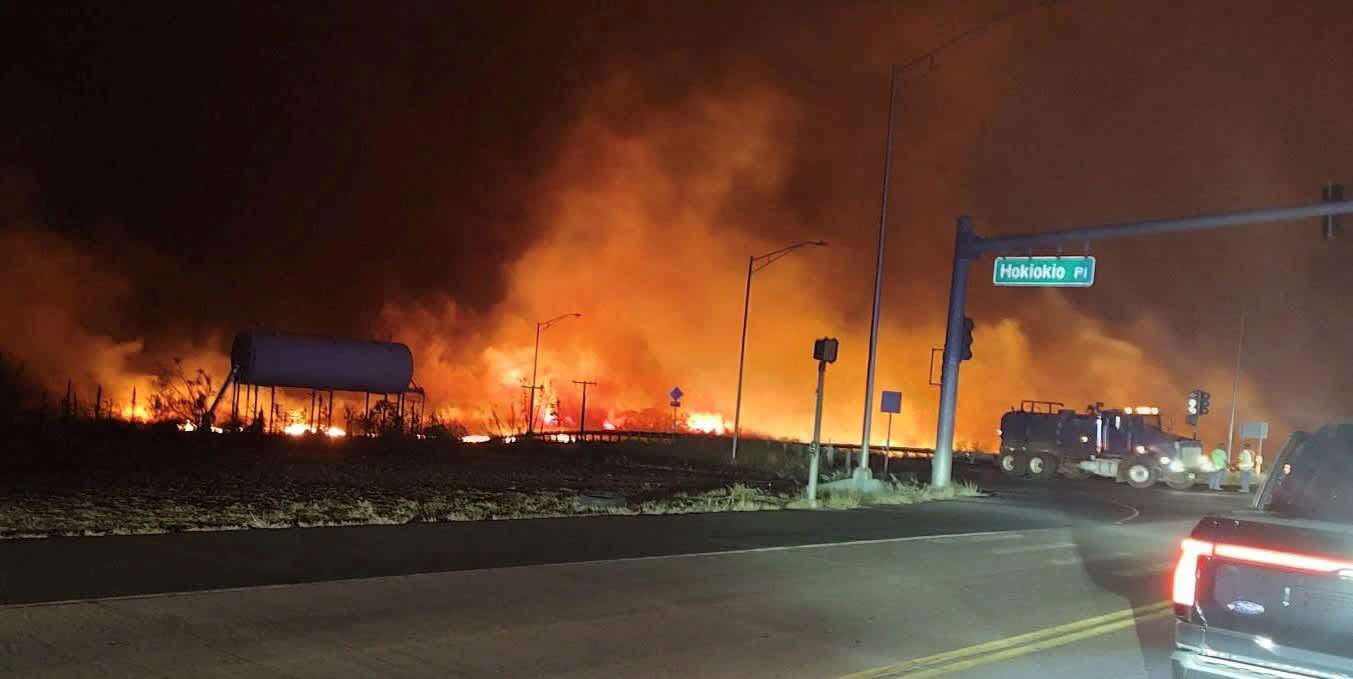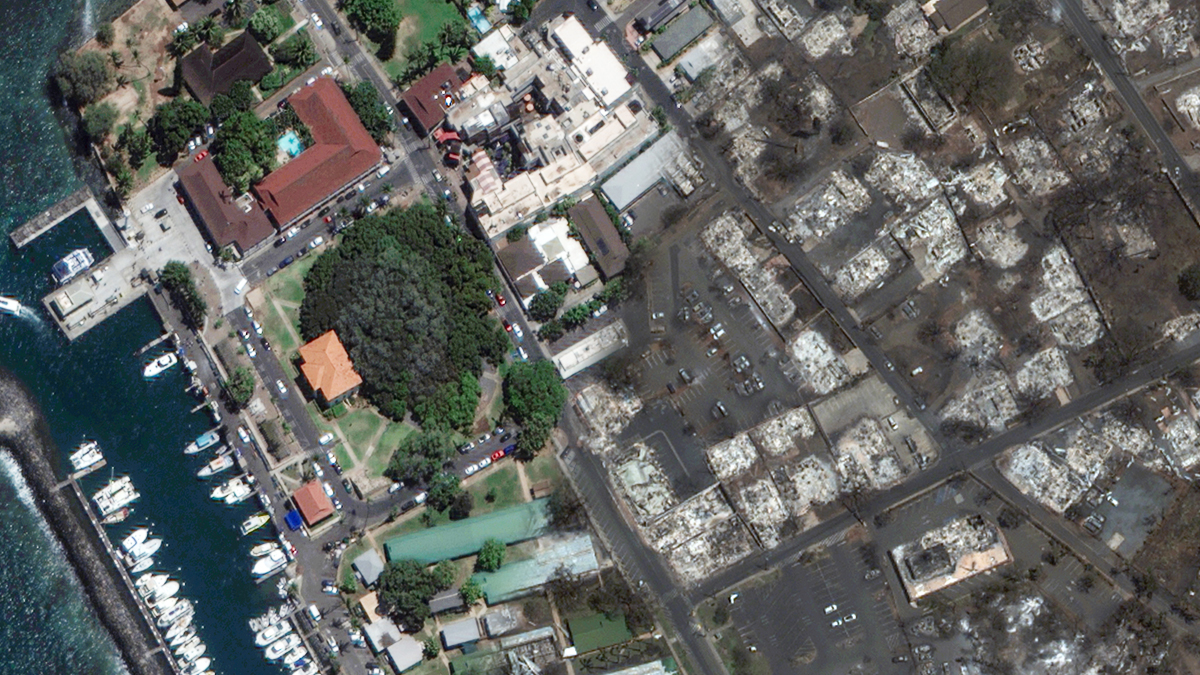Maui residents who made desperate escapes from oncoming flames, some on foot, asked why Hawaii’s famous emergency warning system didn’t alert them as fires raced toward their homes.
Hawaii emergency management records show no indication that warning sirens were triggered before a devastating wildfire killed at least 55 people and wiped out a historic town, officials confirmed Thursday.
Hawaii boasts what the state describes as the largest integrated outdoor all-hazard public safety warning system in the world, with about 400 sirens positioned across the island chain to alert people to various natural disasters and other threats. But many of Lahaina’s survivors said in interviews at evacuation centers that they didn’t hear any sirens and only realized they were in danger when they saw flames or heard explosions nearby.
Thomas Leonard, a 70-year-old retired mailman from Lahaina, didn’t know about the fire until he smelled smoke. Power and cell phone service had both gone out earlier that day, leaving the town with no real-time information about the danger.
Get top local stories in Philly delivered to you every morning. Sign up for NBC Philadelphia's News Headlines newsletter.
He tried to leave in his Jeep, but had to abandon the vehicle and run to the shore when cars nearby began exploding. He hid behind a seawall for hours, the wind blowing hot ash and cinders over him.
Firefighters eventually arrived and escorted Leonard and other survivors through the flames to safety.
Hawaii Emergency Management Agency spokesperson Adam Weintraub told The Associated Press on Thursday that the department's records don't show that Maui's warning sirens were triggered on Tuesday. Instead, the county used emergency alerts sent to mobile phones, televisions and radio stations, Weintraub said.
It’s not clear if those alerts were sent before widespread power and cellular outages cut off most communication to Lahaina.
Asked Friday about the lack of warning for residents, Maui Mayor Richard Bissen told NBC's "TODAY" show that he couldn't comment on the sirens, but said when the fire started on Tuesday hundreds of residents were evacuated to area shelters. He said once the wind gusts picked up — with gusts reaching 80 mph in some areas — the fires spread quickly and out of control.
"I think we were dealing with an impossible situation," Bissen said.
Communications have been spotty across Maui, with 911, landline and cellular service failing at times. Power was also out in parts of the island.
Fueled by a dry summer and strong winds from a passing hurricane, the fire started Tuesday and took Maui by surprise, racing through parched brush covering the island and then flattening homes and anything else that lay in its path.
Maui Fire Department Chief Brad Ventura said the fire moved so quickly from brush to neighborhood that it was impossible for to get messages to the emergency management agencies responsible for emergency alerts.
The wildfire is already the state’s deadliest natural disaster since a 1960 tsunami, which killed 61 people on the Big Island. During a Thursday press conference, Gov. Josh Green said the death toll will likely rise further as search and rescue operations continue.
“Lahaina, with a few rare exceptions, has been burned down,” Green said after walking the ruins of the town Thursday morning with Maui County Mayor Richard Bissen. “Without a doubt, it feels like a bomb was dropped on Lahaina.”
The fire is also the deadliest U.S. wildfire since the 2018 Camp Fire in California, which killed at least 85 people and laid waste to the town of Paradise.
"We've seen devastation, destruction, immeasurable loss, loss of life, loss of historical places, businesses and places," Bisson said on "TODAY." "But I'm confident that as a community we will come together and rebuild. That's certainly out intention."
Lahaina’s wildfire risk was well known. Maui County’s hazard mitigation plan, last updated in 2020, identified Lahaina and other West Maui communities as having frequent wildfire ignitions and a large number of buildings at risk of wildfire damage.
The report also noted that West Maui had the island’s highest population of people living in multi-unit housing, the second-highest rate of households without a vehicle, and the highest rate of non-English speakers.
“This may limit the population’s ability to receive, understand and take expedient action during hazard events,” the plan noted.
Maui’s firefighting efforts may also have been hampered by a small staff, said Bobby Lee, the president of the Hawaii Firefighters Association. There are a maximum of 65 firefighters working at any given time in Maui County, and they are responsible for fighting fires on three islands — Maui, Molokai and Lanai — he said.
Those crews have about 13 fire engines and two ladder trucks, but they are all designed for on-road use. The department does not have any off-road vehicles, he said.
That means fire crews can't attack brush fires thoroughly before they reach roads or populated areas, Lee said. The high winds caused by Hurricane Dora made that extremely difficult, he said.
“You’re basically dealing with trying to fight a blowtorch,” Lee said. “You’ve got to be careful — you don’t want to get caught downwind from that, because you’re going to get run over in a wind-driven fire of that magnitude.”
Mandatory evacuation orders were in place for Lahaina residents, Bissen noted, while tourists in hotels were told to shelter in place so that emergency vehicles could get into the area.
The mayor said that downed power poles added to the chaos as people attempted to flee Lahaina by cutting off two important roads out of town. Speaking at a Thursday afternoon press conference, he said that 29 poles fell with live wires still attached, and leaving only the narrow highway toward Kahakuloa.
Marlon Vasquez, a 31-year-old cook from Guatemala who came to the U.S. in January 2022, said that when he heard fire alarms, it was already too late to flee in his car.
“I opened the door, and the fire was almost on top of us," he said from an evacuation center at a gymnasium. “We ran and ran. We ran almost the whole night and into the next day, because the fire didn’t stop."
Vasquez and his brother Eduardo escaped via roads that were clogged with vehicles full of people. The smoke was so toxic that he vomited. He said he's not sure his roommates and neighbors made it to safety.
Lahaina residents saw the Hale Mahaolu senior living facility erupt in flames as they were escaping.
Chelsey Vierra's great-grandmother, Louise Abihai, was living at Hale Mahaolu, and the family doesn't know if she got out. “She doesn’t have a phone. She’s 97 years old,” Vierra said Thursday. “She can walk. She is strong.”
Relatives are monitoring shelter lists and calling the hospital. “We got to find our loved one, but there’s no communication here,” said Vierra, who fled the flames. “We don’t know who to ask about where she went.”
Tourists were advised to stay away, and tens of thousands of people have crowded airports to leave the island. Officials turned the Hawaii Convention Center in Honolulu into an assistance center, stocking it with water, food, and volunteers who help visitors arrange travel home.
President Joe Biden declared a major disaster on Maui. Traveling in Utah on Thursday, he pledged that the federal response will ensure that “anyone who’s lost a loved one, or whose home has been damaged or destroyed, is going to get help immediately.” Biden promised to streamline requests for assistance and said the Federal Emergency Management Agency was “surging emergency personnel” on the island.
Sinco Kelleher reported from Honolulu, Rush from Kahului, Hawaii, and Boone from Boise, Idaho. Associated Press writers Rebecca Boone, Chris Weber in Los Angeles; Nick Perry in Wellington, New Zealand; Andrew Selsky in Bend, Oregon; Bobby Caina Calvan and Beatrice Dupuy in New York; Chris Megerian in Salt Lake City; and Audrey McAvoy in Wailuku, Hawaii, contributed.



